Hi guys,
I’m in Istanbul sitting up in my Wow Airport Hotel room waiting for my food to arrive that I’ve ordered from Room Service –
Here’s the time:
![]()
It’s the day after I’ve had my hair transplant surgery which started at 1 pm yesterday and finished at 8.45 pm by the time I left on Friday 13th November 2020.

Here’s me right now.
And I want to take this opportunity to share with you my hair transplant journey which ultimately began less than 6-weeks ago.
Pretty much courtesy of a conversation I had with Craig Campbell – who’s just had his second hair transplant done – using the clinic I am now a patient of – Longevita.
Woah!
Table of Contents
What Surgery Looks Like

It’s ridiculous to think that 6-weeks ago I had never considered the idea of having a hair transplant – and now I spent the best part of 6-hours yesterday having a full medical team cut into my head to remove a bunch of hair follicles from the back of my head –
And put it on the top of my head.
Get ready – you’re about to see some horrible ass photos:

This one was at the end of the day of surgery as you can see from the timestamp with the implants freshly made
They look like tiny white specks or the embers of cooked rice that sits atop my head amongst all of the blood and ooze.
I’m so glad I’m unable to see the top of my head whilst this is happening.
Here’s another angle:

What was crazy was how it looks after they wash it though – the morning after:

A huge improvement – now it looks like a very nasty graze that’s being treated.
As you can see from the timestamp – those photos are basically thirteen hours apart.
You’ve not yet seen the back of my head though.
So the top is where the implants took place.
My Bald Head

And I want to show you what sat in its place before that:

This was taken several days before the surgery – and what attempts to grow my hair look like basically.
If you look at the whole area where the thinning hair is you’ll immediately see it’s quite a large area across the top of my head.
You just need to look at the crown of my head (where you see the balding swirl) and then radiate outwards and you’ll see all the places my scalp is visible
That picture above it without light shining down upon my hair was basically taken in ‘the dark’ from a hair perspective.
Now I’ll show you one with a full set of lights being shone down upon it:

Now it should be apparent how thin my hair is at the top.
I remember seeing this photo for myself the first time and actually being shocked at how little hair I had on the top of my head.
My father and I were in a restaurant discussing my thinning hair – and he turned his face down so I could see his scalp and said – ‘look Deepak there’s nothing wrong with your hair – it’s the same as mine’.
Of course, my dad is 64. 30 years older than me – and I think this fact got lost amongst this conversation.
So this is meant to be genetic – but I’m not sure who in my family I get my balding from.
My dad has had a healthy enough head of hair through his life, my brother still has good hair – but two of my three sisters and I suffer from various forms of alopecia – I know it’s something they struggle with as well.
Why Men Go Bald

It’s only been since having the operation I looked more into the progressive stages of baldness –
My sides and back are strong (as most men’s are) with healthy sets of hair – and I’m displaying the common thread of male pattern baldness – which if you google looks like this:

Here are other ‘real-life’ examples:

So as you can see – I’m following the path of many men who ultimately go bald.
There are quite a few people who suffer from this affliction I discovered upon Googling:

And then I found out that my hair loss is actually a very common form of alopecia:

It’s amazing what you turn up with a quick google and look into the statistics behind this all –
‘You are not alone’ is actually what comes to mind.
And as strange as this is to some of my family – as I’ve started telling friends – I’m discovering there is a whole world of people out there who suffer from the same problem – and male hair transplants are now a lot more socially acceptable.
It was actually a new friend – ‘Joe’ who spoke to me about the hormone DHT or dihydrotestosterone – and the role it has to play in going bald.
Basically, it’s a byproduct of testosterone production in men and this is what it does to your hair:

And so it seems that DHT (as per Joe’s explanation – shrinks hair on the top of your head) has no effect upon hair on the back or sides of your head.
With this in mind then – one can get a hair transplant using hair from a donor area such as the back of your head and move it to the top of your head.
And given that not all hair on your head is affected by DHT – it means that once this hair is transplanted – it won’t have the same vulnerability to DHT as the hair that’s thinning has.
Which makes this procedure permanent and long-lasting
Score.
Gosh…
It’s incredible what we will do to just look good, isn’t it?
Why Going Bald Bothered Me

For me, at 34, I still feel full of life, energy, verve and vigour – and so the thought of going bald gets me down – and gets me down enough that I ended up in a 6-hour surgery (I know – it’s a long time under the knife right?)
In a way – lockdown provided me with this ‘curse/gift’.
I decided ultimately it would be a good opportunity to grow my hair out and get the ponytail I’d always been curious about for a few years.
It took me a couple of months to discover that there was no way my hair atop my head would support some ambitions – and so as I began trimming it back – I discovered it bothered me.
Some men – may be most men are fine with going bald through their 30s – and I see that I’m not – as a full head of hair is connected with associations of health and virility and so my desire to do something about it commenced.
And what a journey it’s been –
So with this now -now let’s return to how I came out looking:
Post Surgery Pics
From further away it doesn’t look so bad:

This was the morning after the day of the operation – I’d been sent home with a dressing on the back of my head to care for the open wound you can see in the picture.
Overnight it turned into a lot of leakage upon my pillows:

And then I went and had a cleanup –
If you look you can see the area where the extraction happened – which looks like red raw meat.
Let’s get closer up:


This part actually looks more brutal – as they extract bits of flesh and put them into the top of my head – where you see the white specks/rice.
__________________
The Journey To Getting A Hair Transplant

Now I’ve laid down the groundwork – let’s go back a few steps and talk more about my thoughts of myself and what led me to ultimately getting an invasive surgery on my head done with several hours under the knife.
Around the beginning of October I reached out to Craig on Whatsapp and he sent a video message back with a band around his head – sat in Heathrow airport for a few hours before he headed back to Glasgow.
As he’d tell me – he’d just come back from Istanbul from having a hair transplant – his second.
Lockdown had provided me with an opportunity to grow my hair – because why not?
It’d literally been years since I last grew my hair – back in February of 2012 perhaps if memory serves.
Hang on – let me check Facebook:
Yep – here’s an old photo in fact:

And now 8 years later – for the final time I wished to grow my hair and get it to ponytail length – and here’s how long I managed to get it:


Of course with that, it soon became pretty clear that I’d be unable to get my hair to the length I was interested in because of the giant great f*cking bald bit in the middle (which you’ve seen above – not up for resharing that lol)
So – my cousin Ajay and others made me very aware I was going bald and I discovered it bothered me much more than I thought it would, not that I knew what to do about it.
That was of course before Craig came along and showed me his noggin.
And that was it.
Picking Longevita (The Clinic I Got A Hair Transplant With)

After several back and forth messages with Craig, doing some independent googling, being told he went to Longevita because his mate got it done from there, I’d ultimately a couple of weeks later book in.
I think it did no harm that Longevita seemed to be amongst the cheapest people out there, and there was nothing to identify online that the service would correspondingly be the same.
I spent <£1500 including the procedure and accommodation. A price that had come down significantly during Lockdown (it being closer to the £3k mark previously). I’d later get annoyed when around a month after I booked in they started promoting an £800 offer for the same thing?!
Istanbul and Turkey at large seem to be the centre of Europe when it comes to getting hair transplants. They perform millions each year and it’s something that I think is even promoted by their tourism board because of what an overall boost it provides to the economy.
I mean even now, having come back – I feel a bit of an affinity with Turkey because it’s where I had my hair transplant done.
Getting Over There
In typical Deepak style, I did little/no reading about getting over there and the procedure and what was involved itself.
I simply knew that it could all be done in one day, and some people stayed as little as two nights.
I ultimately booked three nights as per Craig’s recommendation of just hanging out in the hotel the day after as I’d feel sore and would be pretty bloody (that would turn out to be pretty much the case – although adrenaline kept my energy levels higher than I would have liked as it seemed to roll into when I got back into work – which I’d suffer for later)
The gap between Craig getting his surgery done – at the end of September – to myself actually going under the knife was 6-weeks.
Once I’ve decided I want to do something, I’m pretty determined and it tends to happen very quickly. This was no different.
That, of course, has implications for my poor planning.
Thankfully, I discovered 3 days before my trip (which I booked two weeks before I left), when I’d just thought of it upon my pops asking ‘do you need a visa?’ – that I didn’t – and could just fly over there.
Covid Pre-Screaming

However, Longevita had sent me various prep-forms and other emails which I 85% ignored. It was only when I got a WhatsApp message from my team about my flight confirmations that they mentioned – please make sure you’ve had a Covid test done before surgery because if you’re positive we won’t be able to operate on you.
I got pretty annoyed at that because I was like “wtf?! – I need to get this Covid shit sorted NOW? When I’m flying in 2-days? Why didn’t you tell me you knobs?!”.
Of course, it turned out they had made this clear (sort of) on an email, and that I’d ignored it – (of course this would be the beginnings of what I would consider inconsistent Longevita – with the varying and inconsistent recommendations/advice I received from them).
I scrambled, booked a Covid test in for £250+ (which cost more than the flight) at a local pop-up clinic that for about a solid gruelling 45 minutes post-booking I thought was a scam because upon payment I couldn’t get through to them on the phone, couldn’t get a response from their chat and realised their location was a local bloody church.
Thankfully it all checked out, but it was at that moment I got a 2nd message from Longevita that ‘the test wasn’t mandatory – and many people had the test done upon arrival’.
That pissed me off as it sounded like I’d spunked an additional £250 with no need when from the sounds of it – I could get it done for MUCH cheaper/free out in Istanbul.
I didn’t investigate (in Deepak style)/ it didn’t matter because I’d already booked, was in no mood to chase a refund and knew that SHOULD I test positive – well there was no way I’d be getting on a plane let alone having an operation.
I’d ultimately go on to get two tests several weeks later – and both times having a swab rammed up your nose isn’t much fun. It felt like it was about to penetrate my brain as they stuck it right up past the soft fleshy part to where the bones are at the top of the nose.
As you guessed anyway, I tested negative and headed off to Istanbul to get myself cut up.
F.U.E Vs F.U.T

Now, this probably means nothing to you. It meant nothing to me either lol.
But as I’ve later discovered through looking it up, and being told about the method they were using at Longevita (and one that most clinics use I believe) – I was getting the ‘new method’.
This was one of the big differentiators between Craig’s first surgery and his second in fact – which was initially how I got to understand this distinction.
A Follicular Unit Transplant or strip surgery is apparently, pretty old school. This one leaves a scar, and it seems that the recovery process is more damaging if you will than with F.U.E but I’ll explain why in a bit.
Basically, with F.U.T they cut out a strip (1-1.5cm) of hair/skin from the back of your head.
From there they’re able to extract a bunch of hair follicles and put them on ‘ice’ so to speak – i.e keep them chilled to prepare for planting them (like a garden yes lol) on the top of your head a couple of hours/an hour later or so.
They’ll take this ‘strip’ which contains dense hair (they’ll take it from the thickest place naturally), and chop it up to grab all of the hair follicles to start later planting it atop your hair.
This process will leave you with a cracking scar – as Craig has shown me on the back of his head.
I expect it won’t bother you because it’s the back of your head and it’s the last thing people will notice – and with time/hair growth it’ll get less visible anyway.
As they’re pulling out a whole strip (as opposed to follicle by follicle) – you can get denser hair extractions and correspondingly implants from this process (according to ze Googles), and so it’s good for blokes with baldness at the front of the head.
Whether this is true of BS I don’t know, but this is what I read.
Naturally, given it leaves a scar, some consider it old school, and there’s this great new treatment called F.U.E (Follicular Unit Excision) as opposed to this bollocks – I gave this one a cursory Google.
Oh – the other advantages are that you don’t need to shave your whole head when getting this type of surgery as they’re only taking hair from a ‘strip’ on your head.
But this in my mind isn’t any advantage whatsoever. You still need to totally shave your bald/balding area and still need to be bandaged up. And both your donor and transplant area will need recovery growth post-surgery – so personally, I think this is nonsense.
However, one thing I did read that put me off this – is that there’s apparently a lot more post-operative pain with this procedure than with F.U.E – and I didn’t (and am still not) enjoy the recovery process at all – which Longevita (and having googled) most clinics downplay pretty much.
That’s why the ‘forum’ community is so active in this space. The recovery advice is vast and varied – which if you choose to get into it – can be confusing at the best of times.
I’ve been given contrasting advice on multiple occasions by Longevita themselves lol.
You know – I’ve actually discovered more about hair transplants through telling you a lot about it than when I did going in LOL (but I did that with the military as well lol)
So What’s This F.U.E Stuff Then?

So this one I did know some more about because this was what gave me my minced meat head look up top.
This is almost like microsurgery at scale.
Rather than hacking out a strip from your head – this focuses upon taking out hair follicles one by one and THEN planting them up top.
The advantage to this is that there’s minimal scarring (minus tiny dots that are barely visible apparently – I’ll know if I ever shave my head), and to be honest, that’s about it.
Apparently, FUT is still better for those who need coarser hair on top – which strikes me as odd, because ALL men that get hair transplants want coarser hair on top.
Regardless though, this is the new way.
The surgery takes longer because it’s more involved, and comes apparently at a higher cost.
(I guess that depends upon where you’re getting it done though as everything in the UK, by comparison, seems damn expensive lol)
However, I like this picture as an example of the ‘visible difference’ – which is all that anyone cares about:

Look at that scar versus the other blokes head.
Now, I have read the F.U.T leaves you with denser hair – and I guess I need to wait until my hair is totally healed before I pass judgement.
(I’m now 7-weeks out since surgery as you may have noticed the ‘tenses’ have changed – and the result still looks a little shite – but I’ll talk about this later lol)
The Surgery Itself

This is an experience all unto itself, and something I didn’t mentally prepare for either.
In fact, no-one spoke to me in any detail (neither Craig nor Longevita) about what the experience of the surgery would actually be like.
The extent of the advice (I recall) was that I’d been given focussed upon the recovery process and that the surgery used local anaesthetic.
I guess at some level I need to accept I’m not someone who would consider themselves detail-oriented so it’s very possible these documents were shared but I certainly didn’t look if they were.
Some of that has in part to relatively caring free when it comes to doing things out of the ordinary. That has pretty much been the norm for me for years.
Preparation & Medical Forms

You arrive into Istanbul the night before, and all that’s needed really is a good night’s sleep.
Once you head over to the clinic for the medical procedure, there are the typical forms you might expect to see for any kind of private medical operation.
There’s medical sign off (i.e checking if you don’t have some kind of clotting disorder, epilepsy, allergies or the usual list of ‘baddies’/complications), ID verification (photocopying your passport basically) as well as signing some kind of indemnity form.
That’s basically a fancy way of saying ‘I’m aware of what I’m doing, I know and have been informed of the risks of surgery and if there are complications – I take full responsibility.’
You’d expect to see this within any clinic I’m pretty sure.
The Surgical Consult

After forms have been signed there’s some waiting around as you’re put into their queue system before you head in and see one of their doctors.
By this time – Beren – the master of ceremonies/concierge type of person was someone I’d made fast friends with.
He took me into a quiet ceremonial looking room (this clinic looks nothing like you think a clinic might look) and there I sat down next to some kind of graphics of a human head – and then in walked the doctor.
I saw lots of nurses wondering by in the hallway outside of the room chattering in Turkish whilst I was waiting – or rather technicians who would assist with the operation (or as it’d turn out – basically do 80% of it).
Then the surgeon came over – took a look at the top of my head and started marking parts of the print out of a human head for the operating surgeon and technicians to use – and started comparing that with looking at the baldness atop my noggin.
So basically, they come in – eyeball the bald spot, draw it out on their print-out and then show it to you to confirm it you’re happy with that – and then use a permanent marker to draw around the whole area.
What was interesting was he was looking at the front of my head – my hairline basically – and I didn’t realise so clearly that there’s a kind of ‘pokey out’ bit – you can see here where it’s fuzzy at the front:

And that if I wanted – they could bring the rest of my hairline forward to match. In the moment I thought ‘Nah leave it’ – but now thinking about it – depending upon the success of this surgery – I might go back to get the hair on my head even thicker and to get my hairline ‘evened out’.
How Many Grafts?
So Craig has discussed this with me several times – mentioning that the typically – in many clinics – the number of grafts you have determine the price.
As I’ve done a google you will see several clinics offering £5-7 per graft – which means the price is you’re getting 2,000+ grafts can add up to thousands.
I was going to get 3,500 grafts.
Initially, when Craig knew I was getting a hair transplant – the assumption was that I’d need maybe 2,000 grafts – but unfortunately, it turns out (as you saw from the photos above) I’m a bald f*cker – here’s a reminder:

And here’s another funny angle that’ll demonstrate how different the volume and thickness of your hair can be when comparing the back/sides to the top:

Impressive right? If you saw me from the front:

You might think ‘there’s a good looking dude’ – but little do you know that underneath that there’s a bald dude whose about to get this many grafts:

This is the end result that’s passed onto the operating team.
Of course, it being ‘3,500 grafts’ is more of an approximation than an accurate statement – and I don’t believe it’s the case that they mull over this as much.
They’ll do as many as is required to get your hair looking good providing you’ve got enough of a donor area to take from – and as you saw from the back of my head – there was aplenty!
Interestingly, I’ve just noticed nothing was signed (nor asked) about what I wanted to eat (e.g are you vegetarian/any allergies etc – although I suppose the medical part covers allergies) – and I got given a chicken wrap and french fries and salad.
This is basically what I lived on whilst I was in Istanbul anyway. Totally good for my heart lol.
What About PRP?

Whilst I was discussing getting my surgery done with Baren – he also introduced me to something called Platelet Rich Plasma injections to help accelerate my hair healing.
I’d never heard of it before until my buddy Craig had mentioned ‘they’ll ask you about this stuff – just say yes to it’.
The additional cost was something to the effect of £250 and it sounded like it could only be good for me.
‘In for a penny, in for a pound’ was the adage I keep to once I’ve made a decision to do something – and given I was already spending over £1,500 for my hair transplant I thought – ‘what’s another £250 in the grand scheme of things’.
What Is Platelet Rich Plasma?
So from what I understand, platelet-rich plasma is proteins that naturally occur within your body and are often found at any area where there’s a wound to help accelerate the healing process.
It is supposed to help your blood clot – a little bit like what you see happen whenever you cut yourself and the blood will dry up and start coagulating such that it can heal.
Researchers (and many celebrities and athletes besides) believe that there are special factors within these platelets that help accelerate the healing process.
From what I’ve seen, it’s not approved by the Federal Drug Administration, nor is there a ton of clinical evidence to support it – but it looks like it’s been in use since the 1980s.
That means there must be enough anecdotal evidence to support it, and is used for tendon, arthritis, acute injuries, post-surgical repair as well as of course – hair loss.
How Does It Work?

Baren told me, that I would have some blood drawn from my arm, and it would be put into a centrifugal machine – which basically spins the blood around 100s of times (maybe 1000s) for around 10 minutes.
What this does is separate the blood into 3 parts –
- Platelet-rich plasma (thick yellow liquid)
- Platelet poor plasma (pale yellow liquid)
- Red blood cells
The part they’re interested in is the thick yellow liquid which they inject directly into the scalp.
What About Side Effects?

This is the attractive part of this whole therapy I guess – because you’re using your own blood – there basically aren’t any side effects.
The only one’s that will really come up is a consequence of the injection itself – which are the same risks from getting any injection in general
With all of this in mind – it seemed a no-brainer to get it done.
So sign me up!
The Shave

After some more waiting, with the surgeon having drawn all over my head I then proceed to the part that’s for some I guess a little sad.
They shave all of the hair you worked so hard to grow.
Of course, with myself going bald – I couldn’t wait to get rid of it – and I got a distinct vision of what I might look like in the future if I didn’t get this sorted.
Let me tell this story in pictures lol:
It begins:
Chop, chop, chop!

This one deserves a special mention:

The future minus hair atop my head is absolutely shocking.
Looking at this still makes me crack up looooool.
Still feeling positive about the whole thing 😛

End game:

And here’s the specific bits that got outlined:

Exactly where the implants will go:

What’s interesting is if you look carefully at my head you can clearly see the area that’s most bald.
It’s very clearly the crown area wherein several patches there is actually no hair whatsoever. Now if you compare that with the hair around it – there’s quite a difference.
Looking at it – it wouldn’t surprise me if in 2 years from now I decide to go away and get another transplant to add as much volume as possible (but let’s see how this one turns out lol)
The Strip
I want to bring your attention to a specific part of the back of my head:

If you can see where they’ve outlined the strip in pen – you’ll see there’s a section that they don’t touch at all – this is to separate the two areas – donor and transplant areas.
The Donor area is where the hair is being taken from (i.e the back of my head where it’s thickest), and the transplant area is where those follicles are being planted.
Receiving Local Anesthetic

And so, once all these parts were done – full prep, it was just now a waiting game for the operating team to be ready.
You get trawled into the operating room – Beren escorting me in and letting me know if I had any issues he’d be checking in on me regularly to see how I was doing (but the fucker only came back 3/4x during a 6-7 hour surgery lol)
[convertful id=”197358″]
And it begins with stripping down into a medical gown, kicking off your trainers – and then it’s time to get to workkkkk
They do of course make sure you look as sexy as possible with their slippers (that’s the operating team with their togs on)

And then down in the chair, you go to get to work:

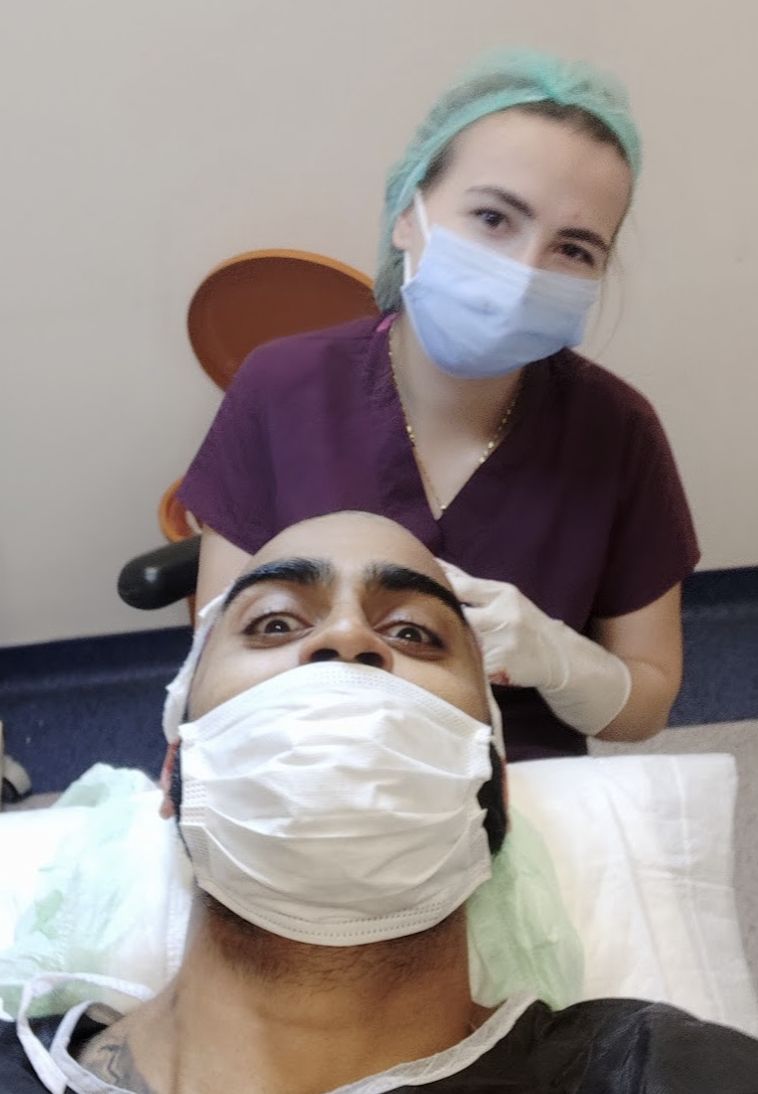
(This was a photo taken several hours into surgery but the only one I have that shows the ‘gown’ in any form whatsoever)
Getting 25+ injections

So this is the part (at least from my reading) that wasn’t clear to me.
How many bloody anaesthetic injections you get as part of the procedure.
I (naively) assumed I’d need one injection to cover my entire head – but of course, it doesn’t and cannot work like that.
Local anaesthetic literally works in a small area around wherever the needle gets stuck in your head.
And as it turns out – that area is pretty small.
I guess that makes sense as you don’t want your head to just go completely numb in one swoop as it probably has other repercussions.
Anyway, as I sat there in the chair the technician said ‘Ready? Little bit of pain!’ in her spotty English.
I said ‘sure’ – and then I felt myself getting lanced.
And then again.
And again.
In the space of a few seconds, as the endorphins started coursing through my body as a response to the pain – I began the pinch method that always helps dampen the feeling of intense pain somewhat.
This is literally me pinching a part of my skin really hard to incite acute pain signals that speed up the production of endorphins in the body to help manage the pain overall as well as distract me momentarily from the injections.
(I watched Dr House do this in House once when his leg was hurting so much that he hit his hand somewhere else to help relieve the pain in his leg – or something like that anyway – seemed very smart and seems to work!).
I didn’t get any prep for this part – the technician just launched into jab after jab after jab after….
Thankfully it only lasted a couple of minutes and then it’s all over (well almost).
Those are the most painful parts of the surgery – and you have to do it twice. First on the donor area as they need to remove hair units by carving you up. And then send when they need to implant these same hair follicles atop your head.
Of course – the second time the technician got around to this I was a little more prepared – however I faced different challenges then which I’ll go on to talk about.
The Donor Area Surgical Procedure
Well. This is how it looks first of all lol:
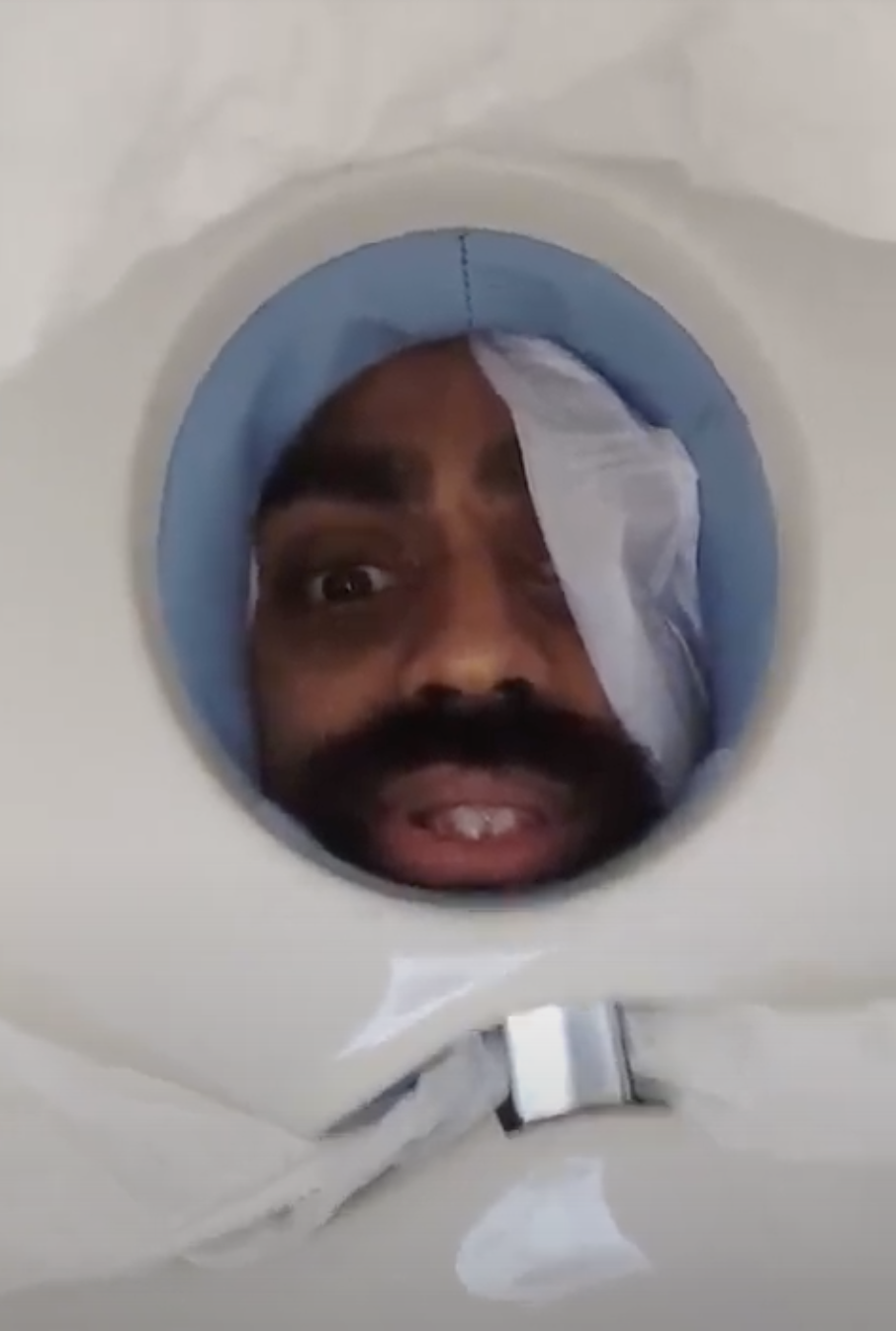
This is a still taken from a video clip after you get laid out on your back to start the surgery.
It’s the most uncomfortable thing ever.
That’s the other part that only becomes clear once you’re in the theatre.
That the most frustrating part is having your face pushed into this tiny little head opening.
It’s not like massage tables and the ‘comfortable experience’.
In this little space, my head was pushed down so uncomfortably as the technicians work to extract lumps of your head that at times you need to bit into the padding with your teeth and just hope no one suddenly pushes down on your head.
Else it would end up being an American History X moment….
And that’s how you spend your first several hours.
I tell you, it’s the weirdest (and not pleasant) feeling having someone take a scalpel, and start cutting into your head.
Literally, the process, even in spite of any improvements there have been in the surgical procedure etc – is ultimately barbaric.
They cut into the back of your shaved head hundreds of times to extract the hair follicles, or root rather and then basically place it in a petri dish which is a cool environment up until you come back to have it all implanted.
As I read more and more about it, I realise I should have read more about it before I went and got it done lol – but such is life 🙂
The technicians will chitter-chatter away (they come in pairs) throughout the procedure, and play Turkish music in the background as they work on your scalp.
It’s obviously very routine in Istanbul, as there are people coming in and out of the whole clinic and the impression I have is that the procedure is totally routine because they seem so casual.
Of course, I assume all of this because none of them spoke good English and it became apparent it was better to shut up and let them get on with it.
I can’t say I enjoyed the surgery at all.
It was a somewhat difficult experience – but I presume that’s normal – surgery is never meant to be fun so what else should I have expected.
Any hopes I had of listening to music didn’t work.
I couldn’t fit earphones through that tiny hole and my ears were being crushed anyway, so I resigned myself to just laying there and entertaining myself with my own thoughts.
You are being continually cut into though, so the space for intense thinking was relatively limited.
I had been told that some people fall asleep during this part (and the 2nd half as well). I sadly didn’t fall into that category.
Things were far too uncomfortable for that to be a possibility lol
Here’s another still from a short video I took when I ran out for a toilet break:

This I think was actually headed into the 2nd half of the surgery – but it shows you my bandaged head with the shower cap that’s in place to prevent infection getting into it.
The gown (do you call it that?) that I’m wearing demonstrates what you look like whilst you’re being operated on.
And then you’ll notice the little patch I’ve got on my right forearm which is another interesting story of itself – which we’ll come to later – for now, the surgery
Dinner Break (3 hours or so later)

Once the first half was over, it had already fit maybe 6 pm on Friday evening.
I’m not sure of what the expectation is in Istanbul or rather the clinical hair transplant/private medical environment – but in hindsight, I didn’t think this through.
As Friday represents the weekend it’s when surgeons are likely to be more drained and have their mind on just wishing to get out of the theatre and start enjoying their weekend.
So as I was bandaged up and left the operating room to quietly eat my dinner whilst the anaesthetic had time to do its work at the top of my head – I also saw the surgeon’s in the cafe eating their dinner as well – half watching me see that I was relaxed, and eating, but also to see how quickly I’d finish eating.
I swung around and peered across the cafe – I looked to be the only person still being operated on in the place.
The last man standing!
It wasn’t really where I wanted to be and I would recommend those going to get things done on a Tue/Wed/Thur as ideal days.
There’s no specific data from this world to back that up haha – but just my assumptions based upon how I feel during my working week.
Anyway – dinner got finished and back into surgery, I went.
Yet More Injections

So now we dive into the 2nd half of the surgery – the part that requires more precision – and when I saw the surgeons take a much more active role in the operation.
In fact, preceding this – I don’t think I saw the surgeon come once into the theatre for more than 5 minutes at a time to check how things are going.
The technicians were leading the charge – but now it was the time for the surgeon.
And this 2nd half had – as with the first half – begun with injections.
Getting 10-20 injections now once again, but this time atop my head (painful) had me again looking like this when I headed to the bathroom:

This one’s from around 7 pm

Check out the bloody patches in this one. Grim.
I tell you, it’s surreal being in that environment and then wandering into the bathroom to look at yourself and take a selfie.
The last time I’d had local anaesthetic was more than 20 years ago when I had some teeth removed before getting braces.
Getting the implants atop your head (if you can call them that) isn’t pleasant at all. But to even make that happen – they, of course, need to numb you up first to get prepared for the cranial massacre to follow
_____________
‘Ready?’ The nurse had said in her thick Turkish accent as she had prepared the needle for the anaesthetic.
‘Ready!’ I had exclaimed as I stuck my thumb up from my clenched first for her to see as she began needling my scalp quickly to inject the anaesthetic.
It’s a pointed piercing pain that isn’t pleasant at all, and again I had no sense of how many injections I needed – nor could she tell me.
After the first 12, I accepted that it ‘might go on forever’, as time seemed to slow down and the world around me became a black void, as I rushed inwards into my protective space to just cope with the pain.
…….
….
…
2 minutes later, after a couple of winces from me and around 20 injections overall – it was done.
Donor Area Surgery
Now it was time to get down to business –
Time to open up my cranium, the dome, the top of my head – and to start laying seeds
This is the part I would absolutely care to forget.
I’m sure you all know the sound of a crunchy apple that you bite into, and the satisfying sound it makes as you scratch chomping your way through it.
Well – little did I realise that my head would make exactly the same sound as the surgeons started carving into it.
It’s not pleasant at all, and each time you would get a slight sensation of pain – the surgeon would realise through the little yelp you made – and then would grab more anaesthetic and needle you to get you dosed up further still.
I think I ended up having maybe 10 more injections to get my scalp completely numb.
And because I could hear and feel (absent the pain) scalpel cutting into my head – it’s a really really unpleasant experience.
It’s at this moment – because you are awake and can sense everything that’s happening – you’re in this weird space of being able to talk to the surgeons as well as play with your phone – and generally be indulgent in the experience a lot more than the fast half.
The first half was you stuck head down trying to breathe to survive (although as mentioned somehow, some people fall asleep).
The second half you see the surgeons getting to work – and it’s the first time in the whole procedure where you don’t sense routine as such – but you sense focus and precision.
You sense surgeons who are focussing on getting placements just right as they lay down what will ultimately become a whole new head of hair.
By this time it was the evening, the two surgeons, and two technicians – so the four-person team were coming to the end of the shift.
Things had loosened up a little – the door slightly opened in the theatre, music was playing from the other room and you could sense a higher degree of relaxation and also an eagerness to get home.
I wish I hadn’t booked a Friday night slot as I said lol – but c’est la vie – I’ll never know if it would have gone better because you get what you get – there’s no ‘do-over’ – only improvements.
It’s Done

And right – it’s time to bring some of those photos back:
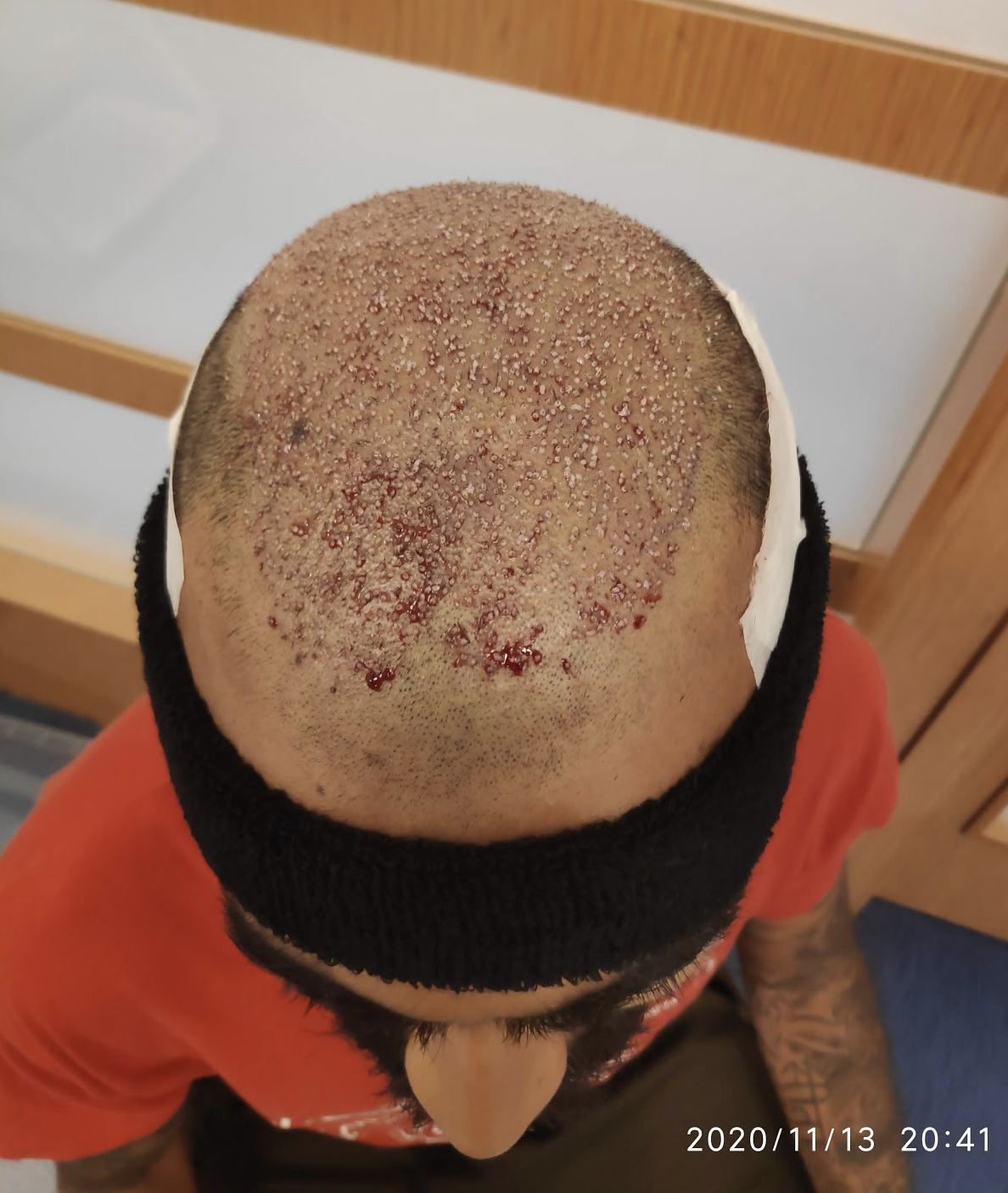

This was me at the end of the surgery at 2041 – ready to finally head home – with my new hair transplants freshly inside my head.
I was tired, but feeling in high spirits and high on adrenaline – I wouldn’t sleep much that night – nor any night for the next week – as I entered the next stage of my hair transplant journey.
The Wonderful Headband

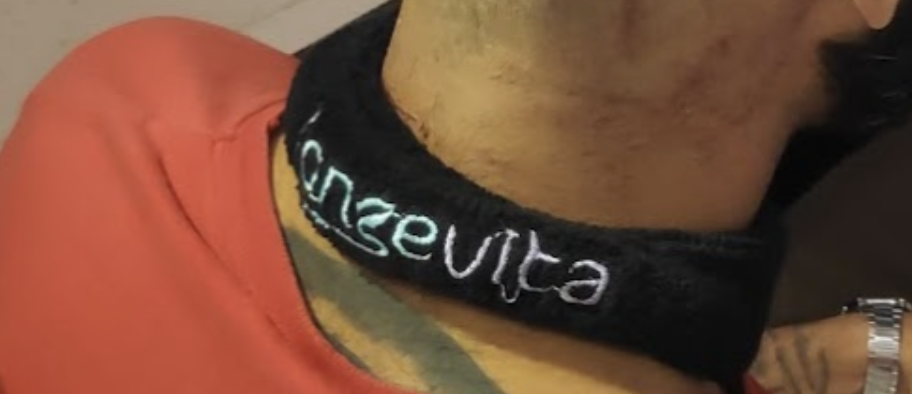
So you might have noticed this lovely headband I am sporting in some of my pictures – and it’s important to explain its use and importance to the whole process.
The headband is basically kept on for the first week (yes the whole of it minus showering from dusk till dawn) to ensure the swelling is managed.
Think about it – you’ve just gone through very invasive head surgery, and it’s probably not much different from experiencing head trauma.
This means your body is going to send every white blood cell to the area imaginable as it goes on a healing rampage.
To project the site of damage than – your body will produce swelling because of the increased blood flow – and is a sign that work is happening in that area.
Thus the swelling and pain is a reminder that there’s a problem in that space and that you need to be mindful of it.
Craig is the first person I saw wearing such a headband and the difference from how it protected him versus when he got his first transplant (F.U.T) and it looked like he’d gone through several rounds with Mike Tyson was stark.
In the F.U.T/Longevita instance – the headband is used to help manage the swelling and have it drip down your scalp slowly – instead of rushing down to your eyes and causing lots of bruising.
As you can see several days later – the process works:

This was a moment when I chose to take the headband off to give me some temporary respite from the continual bad headaches you’ll get in the first few weeks post-surgery.
But the band apparently stops you from looking like this:

Giving it a quick google – this is what comes up:
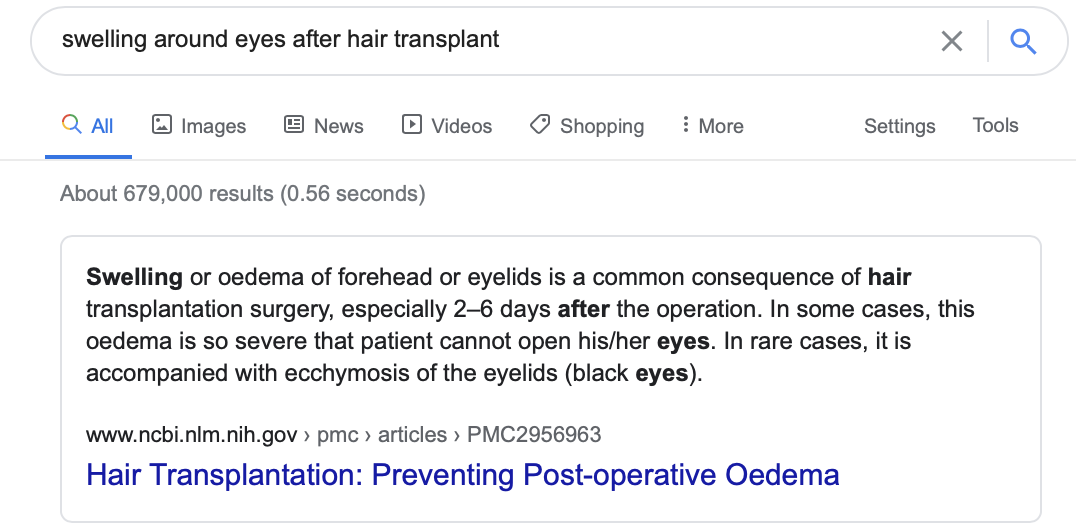
This is the experience that Craig had the first time around when he had his FUT – and the pictures he sent me (I wish I still had them – are like a horror show lol) are still vivid in my head.
Anyway – what you don’t discover (until you get the headband itself slapped on your head) – is that it gives you the absolute WORST headache in the world.
Of course, that’s partially the hair transplant itself (or maybe most of it) – but the first week for me was all about trying to work through those darn headaches.
My First Wash and Aftercare Discussion

After a sleepless night – I headed back over to the clinic and had my aftercare consultation which then got me into being shown my ‘goodie bag’ with all of the meds etc.
But not before you see what’s ‘living’ on the top of your head.
The top of your head pre-wash looks horrendous – but once they apply some special lotion to your head and wash you down –
It doesn’t look too horrendous (but all the same it’s not for the squeamish lol) – just looks like you’re freshly healing after being stuck with 1,000 pins

(Same image I shared with you at the top of the blog)
So once I got a sore wash and had myself wiped down – I got off to see my after transplant advisor.
One thing you might notice – is that I’ve still got a line/band of hair here:
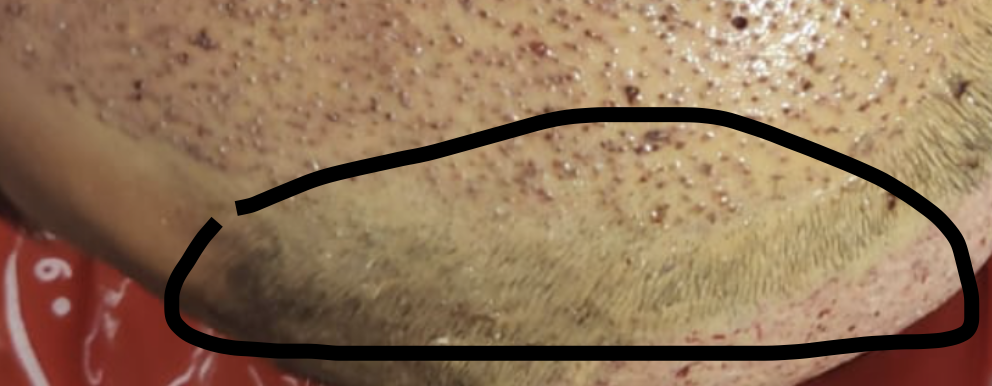
It would have been nice if they just shaved that off post-surgery – because as it grows back that definitely looks a little funny.
Although I presume it probably is useful to separate both those gruesome areas which you can see how this picture is blown up.
I think in hindsight – it feels like the back of the head takes the most initial damage. It looks like canned meat.
But the recovery process for the part that matters – the top of your head – takes far longer and with there being actual implants – it means healing is a lot more complex shall we say.
So this was all done by 10 am and then Baren – my advisor/consultant for my time in Istanbul – will then walk you through everything you need to know in terms of aftercare.
Here’s the dude:
Gotta appreciate the Covid look:
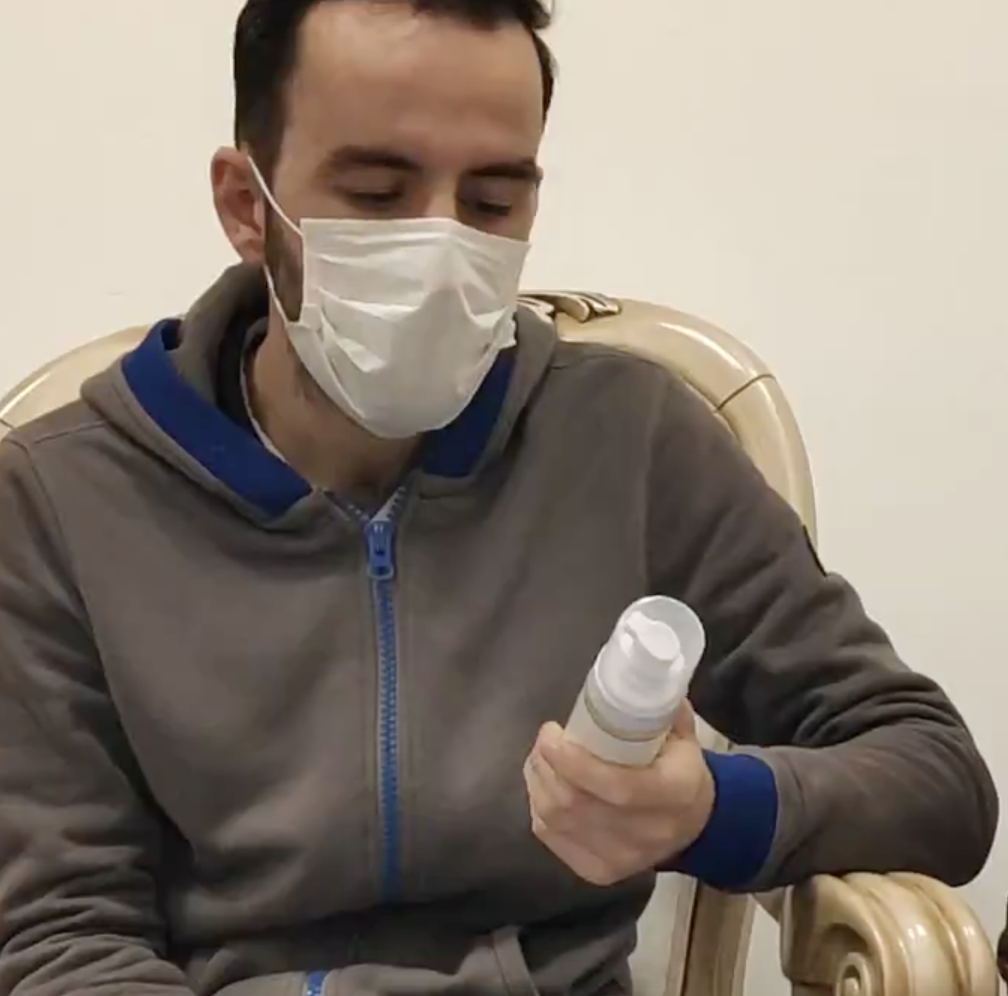
You might notice he doesn’t have a hair transplant/full head of hair – which was disconcerting but normal I guess lol.
I’d love if they only hired folks who had hair surgery like myself – but then that’s pretty limiting.
Anyway, the sh*t in his hand is some aftercare lotion that you need to rub onto your head (by rub I mean dab) for the first 2-weeks after surgery.
That’s followed up by using some shampoo on your head right after.
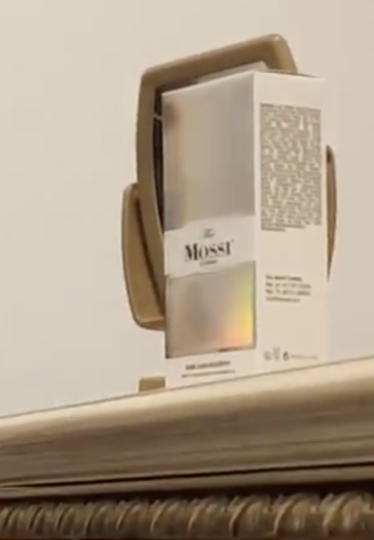
Here’s a pixelated still from the video. Some kind of Mossi aftercare lotion (I’ll look it up later)
Outside of this, you get some pretty strong painkillers as well as some ‘anti-swelling’ as they call it that you need for the first couple of days:
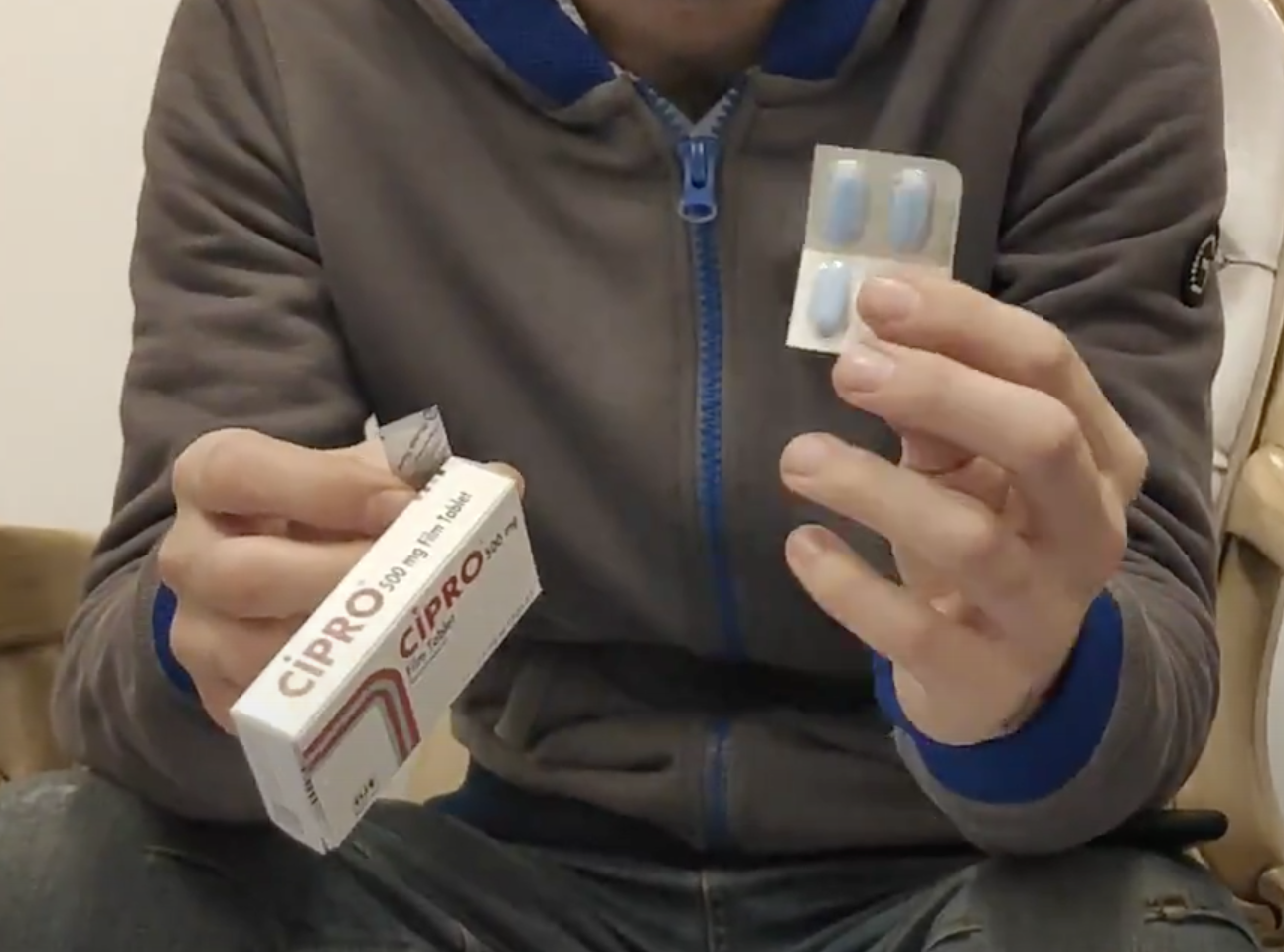

Upon a google this is actually what it is:

That makes sense – try as you might – you’re going to see your head a little dirty between flying back to London and sleeping each night.
And this is what the goodie bag looks like:

Incidentally – I had to (naturally) the morning after – figure out how to wash myself.
This is a still from another video of me trying to figure out how in the frick to do that:
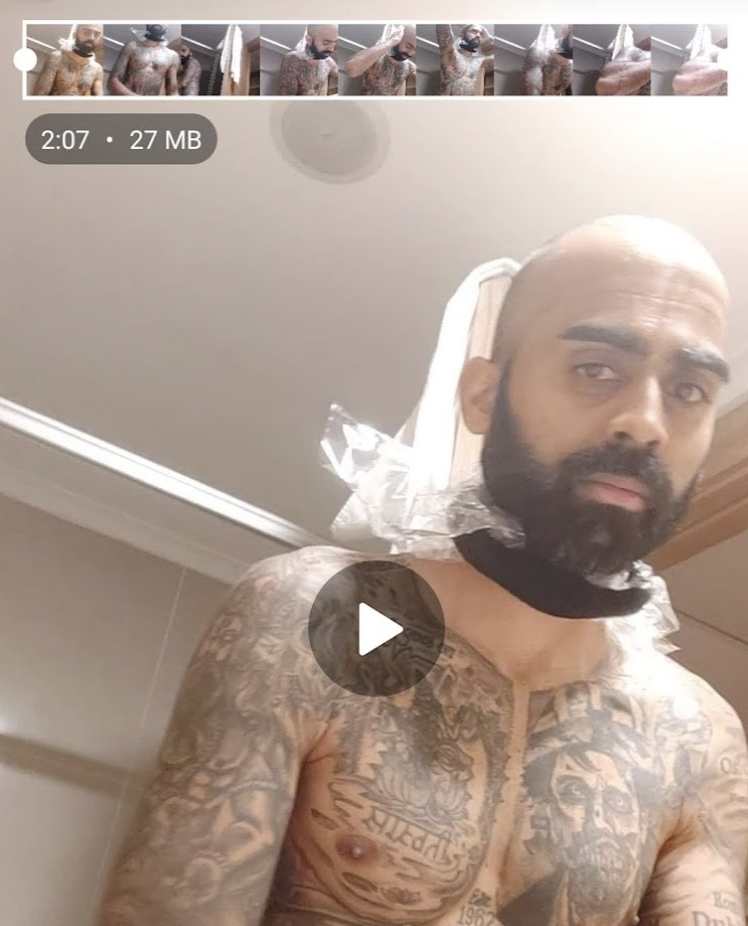
I sent this to Joe – a chap I met out there who also got his surgery done the same time as well.
We were both up at 440am washing our hair before we jumped in the cab to head to the airport.
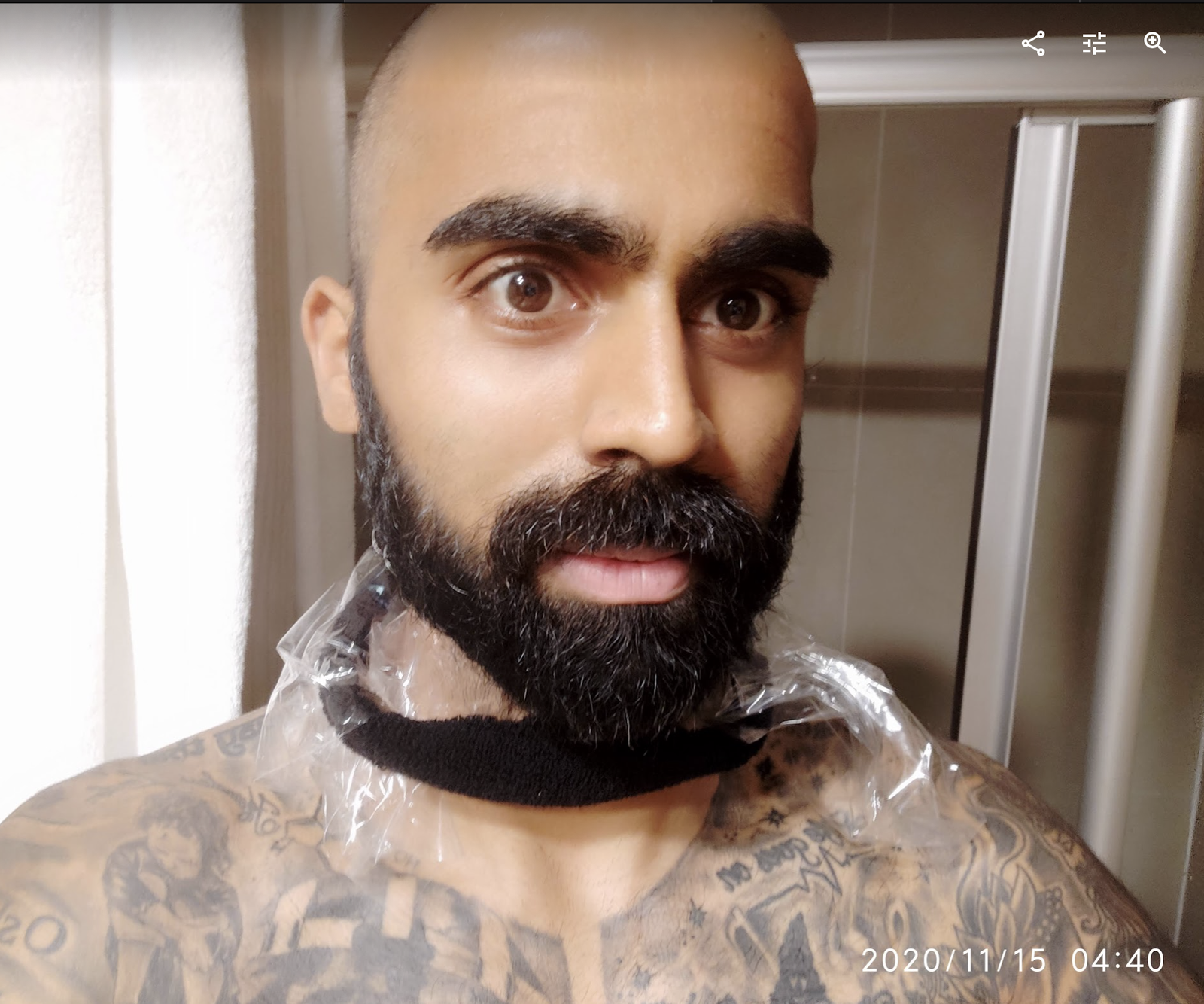
Now the big challenge – is NOT taking your headband off (i.e above your head) – and NOT getting the f*cker wet lol.
I (not knowing better than) got some plastic wrapping that some of my haircare lotions were in and wrapped it around the headband.
I made a mess of everything and as you can see – what I put together doesn’t look right and it was awkward as hell.
But….I didn’t get the hairband wet….much 😛
The Plane Ride Home

So I warn you.
I hope you’re not shy and retiring when it comes to going to the airport and making your way home.
Thankfully – you can’t see your own head (but of course you can see your mates/others if you go with friends).
And you can also see the crowds of other hair transplantees like yourself who’ve undergone the same procedure.
I was sat in the airport with Joe looking like a car-crash victim – as some ladies actually asked if we were ok…
(I would show you a picture of Joe but the basta*d won’t let me loooool)
And then the ladies asked to take pictures of us (or rather the bags) as they asked ‘who are the company we got the hair transplant from?
After all of this, it was with a sense of relief that I then I saw a bunch of Italians next to me all looking like lemmings just like we did lol
Here’s a picture I grabbed from Google:
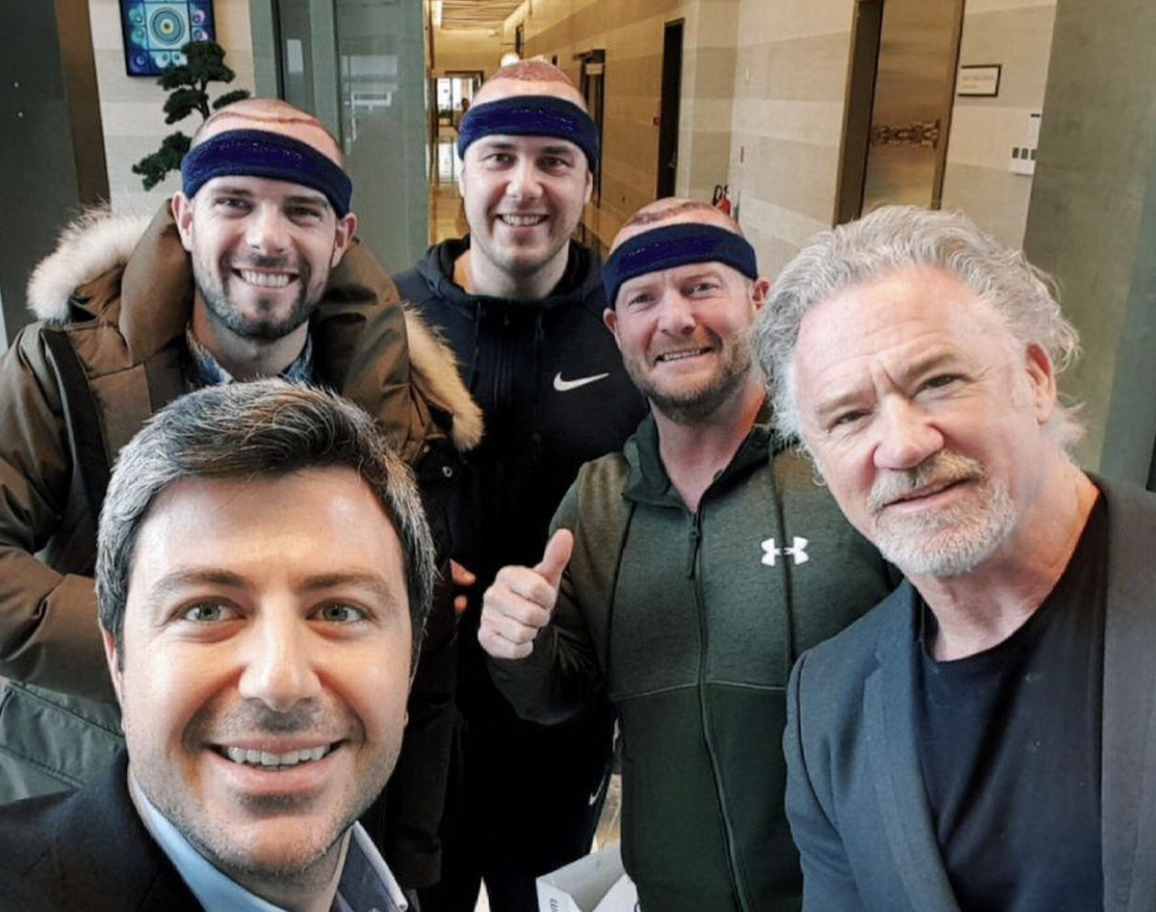
And that’s basically how you look when you head to the airport.
Now interestingly that picture is from a news article with a company that actually provides a concierge service for those who want to get their hair done as I have.
The fact that they actually take you out (there and back) underlines how self-conscious this sh*t can make you feel.
Oh well!
You gotta do what you gotta do lol.
My Next Two Weeks

This is where the real journey to recovery begins.
I distinctly remember Baren telling me that ‘the hard part is over now’.
Lol – what a crock of sh*t haha. For me – the hard part began when I stepped out of the operating room and entered the most critical phase of the recovery process.
The next two weeks!
Let me go through some of the crucial considerations when it comes to this phase:
- No sweating in the first month (i.e no exercise, no sex) – this is to prevent your pores from getting blocked on your head as you’re body is trying to heal your head as well as grow new hair all at the same time
- No caffeine/fizzy drinks/bad food etc – this is your body is getting the nourishment it needs to heal properly
I should really just skip these parts and talk to you about the part that’s really most difficult –
The pain, the sleep and the itching.
So think about it – you’ve just gone through massive amounts of trauma on your head – and therefore your body will want to heal the location as much as it possibly can.
That’s going to cause swelling, and it’s also going to cause pain – and you get both in spades.
What compounded this pain was my inability to sleep.
You have to sleep at a 45-degree angle and cannot turn on your side because it could interfere with your grafts and cause the swelling to become uneven.
Furthermore, when leaning back to basically need to keep your head off the pillow because else you risk the transplant site getting infected as well.
I quickly took to sleeping in the front room and basically didn’t sleep at all.
As your head itches, you have to shower extremely carefully i.e 30 minutes of the foam solution followed up by showering with lukewarm water and ever-so-gently pouring it on your head – it makes for a bit of a miserable existence.
This is the stuff specifically that I was given to lather upon my head:


The upside of all of this is that your body actually is healing – it’s just agony.
By the evenings I was getting intense headaches due to a combination of the actual operation and sleep deprivation all combining together to almost debilitate me.
Now a word of warning – I chose to actually continue working through this period – and in hindsight, I don’t know how sensible that was because the anxiety of work meant I was unable to rest and relax properly and instead was just stressed out.
Odd Pains, Odd Headaches An Inconsistent Healing

Unfortunately, no one heals in a uniform fashion – i.e the guy I met Joe had a broadly similar but NOT the same experience as me.
This means that you get paranoid and start reaching out to Longevita to try and get all of your questions answered.
I wish I had better prep for all of the paranoia that followed.
On the basis of the advice I’d get from Google, Joe, Craig and my own intuition – I tried several things to help manage my pain and discomfort – from antihistamines to painkillers, saline spray, arnica, and several other items.
This is notwithstanding the various medical advice I got from Longevita based upon how I was feeling.
They have a Zendesk aftercare email type service where you can send in photos of your head alongside questions and then within 24 hours, they get back to you.
It’s annoying at times, but then OVER time – I see why they have the system set up in this way.
It’s to stop people like myself constantly harassing them I expect lol.
But between their advice and my own independent study I did manage by the end of the 2-weeks day 12 onwards when I discovered a ‘better method’ of sleeping once my swelling had gone down sufficiently – begin to feel better.
Things I Wish I Had Known Earlier

I wish I knew to take some time off immediately after the surgery.
I went in and got the surgery done on a Friday – and I was back working on Monday.
The impression I had was that you could immediately go back to work.
Unfortunately – the work I do requires using my head a fair amount, and whilst I definitely was able to work – what I didn’t account for was how the headaches AND the lack of sleep would impact me.
Over a couple of days not sleeping well at all – I began to feel wretched and this impacted everything else in my personal life – so if I was to do it again – I’d definitely take the first 2 days off so I have a 5-day clear run of no work.
Seeing Most Of My Scabs Fall Off
There was a period – for me at least – where I was basically able with some gentle rubbing of my head – have 80% of my scabs fall off.
The idea of someone if they’d have been watching that would be quite horrid.
The feeling of getting rid of all those horrible scabs on my head was very satisfying though.
Longevita tells you that within the first 2-weeks – aim to rub all of your scabs off gently in the shower.
And you’ll have hundreds of scabs all over your head as the healing process takes place.
It feels like you scraped your head against a slab of concrete – and all the while you’ve got hair trying to regrow (your regular hair) as well as the new hair trying to come through.
So it feels all a bit rubbish.
What isn’t made clear (enough) is that the scabbing process and the time at which it falls off is a little different for everybody.
In my case – it was not until the very end of the 2-weeks that I had them all fall off.
Joe had his come off after around 10 days, and I needed another 4 to 5 days before they ultimately came off.
1 Month Later

So, once you see all of the scabs fall off, you can begin to get back a lot more to your normal life.
There are still patches at the back of your hair from where the hair regrowth at the back if your hair is staggered – i.e it doesn’t grow back evenly – and the same can be said for your transplanted area where different patches of the hair grow back at different rates.
So I think the important thing to consider after one month is that unless you look very very carefully at where all of the new implants are – it won’t look too much different from how your hair looked previously.
Shock Loss With Your Hair Transplants
This is something that you should expect to occur in several cycles with your hair as well.
I.e your hair will grow a little and then basically fall out again.
This is because your new hair is growing out potentially causing existing hairs to shed.
Anyway, from googling, I’d say that significant shock loss occurs in very few men.
I certainly didn’t experience it in any kind of dramatic way.
What I did see was that hairs would grow a little, and then when I shower I’d see some fallout – and this was (and is) a cycle that somewhat repeats itself for several weeks.
2 Months After My Hair Transplant

The hair is beginning to actually come in now – i.e I can see the new hair growth and whilst it’s thin on the ground – there’s definitely more hair –
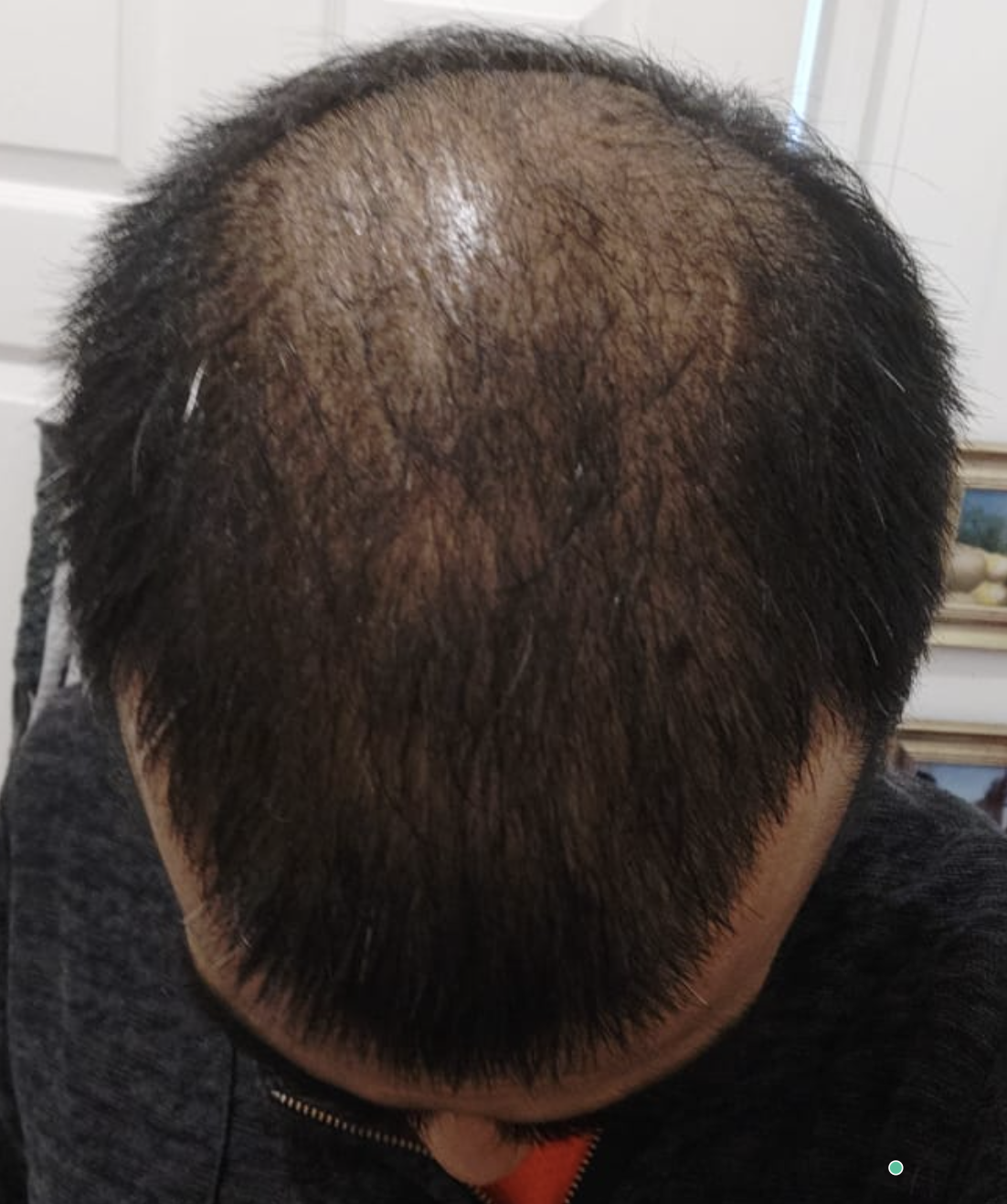
I’m excited to see what the results will bring in the coming months – but this is where I’m at.
The Hair Transplant Recovery Period

The whole period takes up to a year before you see the final result – so I know it’s going to be something of a journey until I get to see the full outcome of the recovery.
But I can already see my hair’s going to look better than it used to.
The only frustrating thing is that the hairs that are original atop my head are going to continue thinning out as they don’t have the same kind of protection from DHT as the implanted hairs have.
So that is the other element of this to think about that I’ll maybe need to have another transplant depending upon the thickness that I’m after in a couple of years from now.
Taking Biotin and Zinc

Amongst the advice that exists online – there are two supplements which I’ve been recommended which I admittedly use inconsistently.
This is the taking of Biotin and Zinc to help with my hair regrowth – but I’m telling you as it’s recommended 😛
Other Options such as Minoxidil and Finasteride

There is indeed a whole range of tablets and sprays and the like you can take to help with your hair regrowth – and these are amongst them as well.
I’ve taken a brief look into both – and for the moment I’ve decided to take neither as they seem to suppress hormones within your body – and well…
The idea of it seems to freak me out.
With all of that being said – there are thousands of men who take such supplements happily and healthily without any problems.
Furthermore, there is clinical evidence that demonstrates these tablets to help with hair regrowth – and the side effects are definitely on the narrow side.
PRP Treatment Programme

Over the next 3-months, I’m going to be getting PRP treatments so ensure that my hair growth is strong and healthy.
It involves going in 1x a month to see a doctor to get a series of very tiny injections into my scalp of the PRP from my own blood and I’m told that I can begin seeing results in a short time as one month.
Admittedly – I AM seeing results and it’s difficult to determine exactly what is driving the result – whether it’s my own healing or the combination of potions of otherwise haha.
But I did go in to get a treatment done and had around 90 tiny injections into my scalp – which after getting a hair transplant – are pretty much painless.
So overall I’d definitely recommend this treatment.
I guess the idea is – is to do anything you can to help improve your hair regrowth!
Final Thoughts

Well, the journey hasn’t finished yet but it’s already been a journey to get here – and now the most traumatic parts of it are over.
And now – I’m at a stage where I can really see that I have more hair than I used to, which is excellent 🙂
I’m excited to see what the next several months will bring in terms of new growth!
So all in all – I’d recommend Longevita as a company to go ahead and get your hair transplant with!



